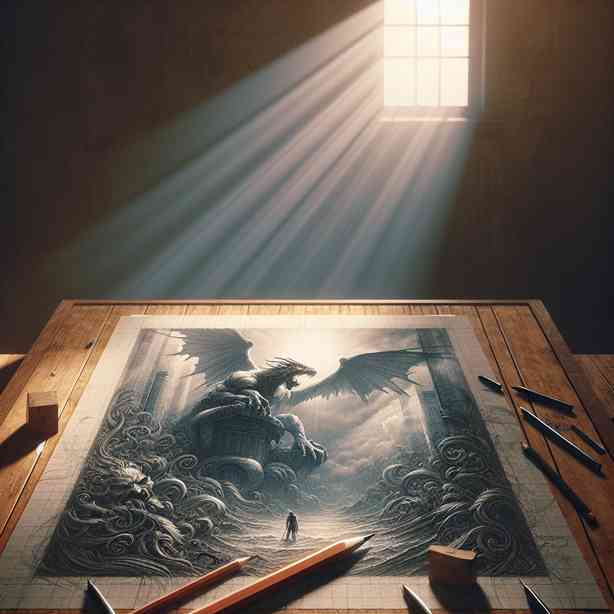
In the journey of artistic expression, there are moments that can profoundly impact an artist’s motivation and inspiration. One particularly poignant experience can be encapsulated by the phrase “The Drawing That Made You Quit for a While.” This concept resonates deeply with many artists, as it highlights the emotional and psychological challenges they often face in pursuing their craft. In this piece, we will explore the factors that can lead to such a moment of contemplation, the impact of that drawing, and ultimately, the path back to creativity.
Every artist has a unique relationship with their work, influenced by personal experiences and expectations. For many, the creation of a piece is not just a display of skill but also a manifestation of emotions, thoughts, and a part of their identity. When we create something that we feel passionate about, it can be exhilarating. However, the opposite can also be true—a creation that falls short of our expectations can lead to a sense of inadequacy.
Imagine spending countless hours on a drawing, pouring your heart and soul into every stroke, only to step back and feel an overwhelming sense of disappointment. This might arise from a myriad of reasons: perhaps technical skill didn’t meet your vision, the piece didn’t convey the intended message, or maybe the reception from peers was less than favorable. Such moments can lead to self-doubt, questioning whether one should continue pursuing art or take an indefinite break to recharge.
In these instances, it’s important to recognize that many seasoned artists have encountered similar feelings. Art is inherently subjective; what might resonate with one person may not connect with another. This subjectivity can be both a blessing and a curse. An artist may find themselves caught in the trap of external validation—seeking approval from others rather than focusing on personal satisfaction derived from the creative process. When a highly anticipated drawing becomes the catalyst for quitting, it often serves as a harsh reminder of this dynamic.
The emotional weight of disappointment can be difficult to navigate. It can induce feelings of isolation, frustration, and even a sense of loss for a passion that once brought joy. During this period of withdrawal, an artist might find themselves grappling with an internal dialogue that questions their abilities, dedication, and potential. The subconscious comparison to other artists can exacerbate these feelings, as one might perceive the perceived ease with which others create as an unattainable standard.
However, the act of stepping away can also serve as a powerful form of introspection. A break from artistic creation doesn’t necessarily equate to an end; rather, it can foster an environment where an artist can reassess their motivations and aspirations. This hiatus might allow them to engage with other forms of inspiration—be it literature, music, nature, or other art forms—reinvigorating their creative spirit in unexpected ways.
The beauty of art lies in its ability to evolve. An artist’s journey is not linear; it is common to experience peaks of creativity followed by valleys of doubt and inactivity. During the hiatus, it can be beneficial for an artist to explore new techniques or styles without the pressure of expectations. This exploration can bring a sense of freedom, allowing for personal growth and the nurturing of one’s unique voice. Making art should ultimately be a source of joy, and prioritizing that joy can help to reignite passion.
As time passes, and with gentle encouragement from within, many artists find the courage to return to their craft. This comeback can be marked by a renewed perspective—viewing past disappointments not as failures but as valuable lessons. The drawing that once made them quit for a while transforms into a stepping stone on their artistic journey, enriching their experience and honing their skills.
When embarking on this return, it may be helpful to create a safe space for exploration without judgment. This means allowing oneself to create freely, embrace imperfections, and even revisit earlier works with a fresh mindset. Such practices open the door to growth and rediscovery, as artists begin to reconnect not only with their skills but also with the joy of creation itself.
Ultimately, it’s this cyclical nature of creativity—of inspiration, stagnation, re-evaluation, and growth—that defines the artistic experience. The periods of doubt serve to deepen our understanding of ourselves as creators, while the act of creating continues to act as a medium for self-expression and communication. It’s about creating a dialogue with oneself and the world—a dialogue that can shift and change over time.
In conclusion, the drawing that once made one quit may serve as an anchor point in their artistic narrative. It represents a moment of trial, a challenge that many artists face at some point in their journey. Instead of representing an ending, it symbolizes the resilience of the creative spirit. The path back to art is often paved with lessons learned, new experiences, and a renewed sense of purpose. Each drawing and every moment spent creating contribute to the larger tapestry of artistry, leading ultimately to a connection with oneself and an understanding that creativity is a continual evolution. Embracing this ongoing journey allows artists not just to create but to thrive in their passion, turning challenges into opportunities for growth.


